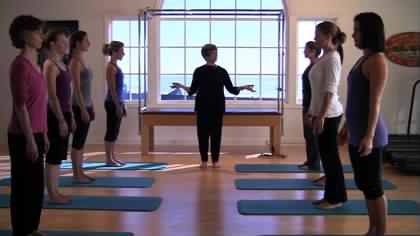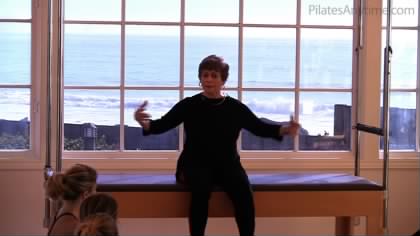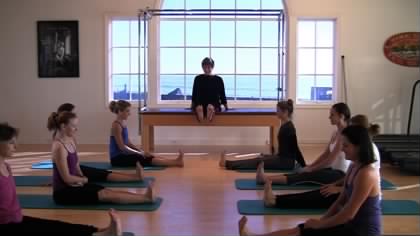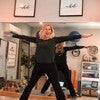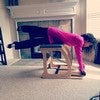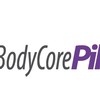Description
About This Video
Transcript
Read Full Transcript
All right, now we're standing. And rather than face me, face sideways to each other. And now today we are going to start with an assessment of posture. Posture is the first thing you have to check on your clients when they walk in the door. It is like you're saying, how do you do?
You want to get acquainted with that body. And you want to get acquainted with that body standing, starting right at the feet. Right? We have this plumb line that cuts us in half and falls in front of this ankle bone. And we have a string, a gold string, attached to a helium balloon that lifts us up, right?
And now think of your feet. Spread your toes. And rock your weight towards your heels, and center your weight. And rock your weight towards your toes-- don't look down-- and center your weight. And rock your weight towards your heels, center your weight, and rock your weight towards your toes, lifting the heels very slightly.
And now center your weight. Centering the weight means that 60% of your weight is forward of that ankle bone. 60%. Your heel is down, but there is more weight forward than there is towards the heel, so that at all times, you can go up and down without rocking back towards your heel. Up and down.
And lift through your helium balloon, up and down. And up and down. And just put the heel down, but don't settle the weight back on the heel. Now let's go towards our little toe. We are supinating.
We are leaning our weight out towards the little toe. Close your eyes and see how that feels on your entire leg, all the way up. Feel how uncomfortable that feels? Now center your weight again. Now go in towards your big toe.
Think of lifting your little toe, and feel how it feels in the inside of your legs. Feel how the knee feels, and the groin. And center your weight again. Once more. And we called it going-- it goes out, supinating.
And centering weight. And now pronating, coming in towards the big toe. It drops the arch. And centering the weight. You have a triangle across your foot that goes from big toe to little toe to heel, right?
All those three points must be down, and the weight is distributed across those three points. Now let's keep going up our legs. We go up the legs and we always check the knees. Are they going back? Are they hyperextended?
Are they knock-kneed, rotated out? And try to center the knee over the foot, right? And don't lock the knee back. Think of lifting by the quadricep up. Now place your hands back in your buttocks, in that line where the leg and the buttocks meet.
Now let your pelvis go back a little bit, and feel how soft that feels and mushy, right? The fat cells love it. They settle back there. Now bring your pubis in line with your two hip bones. Now feel there again.
Now you have a crease, right? Now you have an indentation, or a smile. Which means you have a leg and you have a buttocks. Now in the front, your pubic bone is aligned with the two hip bones. Called the pubic symphysis aligned with the two anterior ASISes.
Feel that. Feel-- brings the pelvis under you. Then going up your body, feel that you have a belt on, and that belt lifts up your waistline, away from your hips. That doesn't mean your rib cage sticks out. It means that above that elastical waistline, you are lifted.
You are not crunching down in the torso. You are resisting gravity. Which is really what we are trying to do. We are trying to resist the downward pull of gravity. Axial elongation, lifting through this string.
Pull up, and what is it? It is resisting gravity by thinking tall. However tall you all, think two inches taller. Press gravity away and think two inches taller. Beautiful.
You will be gorgeous, two inches taller. Right, wait, let me adjust it. OK. And now think along the back, the shoulder blades. Think that the shoulder blades are opened.
Open your shoulder blades to the side. Do not bring the shoulder forward. Think of opening through the side. Open the arms and see how wide you can reach across your sides, from side to side, by opening your shoulder blades out, out of your elbows. Right.
Now close your arms without losing that sensation of open shoulders. Right. Cross your clavicles. Think broad, wide. We all have a rectangular box that goes from one clavicle to the next and down to the hip and the hip.
Rectangular box. And that box has to be placed straight. You cannot have your box leaning back or forward. Those four points must be aligned. Right?
Now think in terms of your sternum, which is soft, your rib cage, which is closed. It is not flaring out. It is not a military stance. Your rib cage is always within your body. Open shoulder blades, sternum down.
At the same time, feel you have a light bulb in the center of your chest that projects out. You are tall through here. You are not sunken. You are tall. Now think in terms of your neck.
Right? Your neck should be aligned so that your chin is parallel to the floor, your eyes are always in center, right? Because where your eyes go, your head goes, your neck goes, your spine goes. So therefore, right? Now most people have one shoulder higher than the other.
And it's basically carrying the baby, the phone, the purse. And it usually is tension. And a little bit of a massage in that shoulder, in the trapezius, in that muscle right there, will relax it. And you will see that all of a sudden, both shoulders appear to be on the same line. So be aware of that, the same way as you are of your thumbs being on the same line.
Right? OK. So your shoulders are aligned, your neck is aligned-- how long can you make your neck? Make it long. Giraffe is a beautiful animal.
So think long. Think you have these beautiful earrings that you want to show off. Right. OK, by the tips of your ears, feel you are being lifted up. By the tips, very tip of your ear, you are being lifted up, resisting gravity.
Remember, as your pubic bone lifts, as you zipper up, as you take the belly button to the spine, at the same time, you are lowering down through the back, right? You lower through the back as you lift through the front. So it goes up and down the back. OK. Eyes are in center.
String is attached. And now breathe in and out. You always want to find out if your client has scoliosis. And often people may have it and are not aware of it. So I always have my clients take the head down and follow through, go all the way down.
Right. And then I check. And you always ask permission to touch. Always ask permission to touch, right? And then-- belly button to the spine-- roll back, and you check that the spine is aligned and that there isn't any bulking in the shoulder blades or lifting.
OK? Something else you want to be aware of in this posture check. Feel your arms just next to you. All right. Again, now we're going to breathe.
Inhale. Think tall. And exhale. You are resisting gravity. Think tall.
Feel your feet. Feel the basis on which you are standing. And exhale. And inhale. Pushing gravity away, lifting up.
Lengthening the neck, dropping the shoulders, belly button to the spine. And relax. OK, now sit. Now I always tell my clients that I give homework. I give homework because it takes more than one, and several times a week, that they come simply is not enough.
And one of the most basic things that I give them is posture. And as simple as you go up against a wall, you position yourself a few inches from the wall, and you press your sacrum, your thorax, and your head into the wall, pulling up the belly button, and just breathe. And pulling up, and little by little, you bring your feet further back, till you can repeat that again and have that awareness. If they practice that several times a day, they will see progress very quickly. Just that practicing of posture, that awareness of their posture.
Remind them also, posture is 24/7. Posture is when you sleep, when you are driving your car, when you are watching television, when you're chasing a mouse. Or when you carry your groceries and your baby. When you hold a phone. All of the time, you must be conscious of posture.
Correct posture. And then it becomes a habit, and then it becomes much easier. But the only way you're going to make it a habit in the body is by thinking about it. The more often you think about it, the more you reinforce that. The second thing that I give is breathing.
We know there's plenty of theories on breathing. I am not so much concerned with whether you inhale and exhale through your nose, like yoga people, or like the opera singers that have sung, that breathe abdominally. What I am concerned with is that you maximize your capacity for breathing. That you don't breathe shallow. That you breath deeply.
That you really outs the air so you can ins the air, like he used to say, right? So I also believe that the first exercise people should do when they walk in the door should be breathing. You have to forget about the car being parked, your child going to school, your boyfriend who had a fight, what are you having for dinner? That has to be left outside the door, and you have to walk into the room and be there and now. Right?
So therefore, only one thing does this, and that's breathing. Right? So when they walk in, you have them start breathing. Now I'm going to start you counting to eight, and I'm going to take you up to 12. You're going to inhale through your nose, exhale through parted lips, which was the way I was taught.
And just very easy, very relaxed. And the most important thing about breath is that we live in such a stressful world, and it is the best way of releasing stress. OK? And you are seated in whatever position you are comfortable, with a straight back. And let's find out if that back is really straight.
That straight back should touch three points-- your sacrum, your thorax, and your head. Ribs are out, way out. Sacrum, thorax, head. Wait, chin down. Way back.
Gotta keep coming back. There. Let's get the little ponytail out of the way. That's-- that's a straight back. Let's go back.
Rib cage in the body. That's right. That was a total different awareness, right, of what you thought was straight? So be aware of that. You must do that pole check often.
Because dancers always tend to pitch forward and they feel they're straight. And often, we stick out our rib cage and we think we're straight. Just relax your elbows and let your hands just dangle right off your knees. Right. And feel that straight back.
And now we're going to breathe. Empty out, inhale, and cleansing breath, exhale. And let's start. Inhale, one, two, three, four, five, six, seven, eight. Exhale, one, two, three, four, five, six, seven, eight.
Inhale, one, two, three, four, five, six, seven, eight, nine. Exhale, one, two, three, four, five, six, seven, eight, nine. Inhale, one, two, three, four, five, six, seven, eight, nine, ten. Exhale, one, two, three, four, five, six, seven, eight, nine, ten. Inhale, one, two, three, four, five, six, seven, eight, nine, ten, eleven.
Exhale one, two, three, four, five, six, seven, eight, nine, ten, eleven. And inhale, one, two, three, four, five, six, seven, eight, nine, ten, eleven, twelve. And exhale, one, two, three, four, five, six, seven, eight, nine, ten, eleven, and twelve. Empty out. That is what I call an exercise on maximizing your capacity for breathing.
It is something that if you work on it, will surprise you. You should easily, within a week of working on it, be able to go up to 18. I can go to 30, so. And the more you can breathe, the better off you are. Remember, breathing is three-dimensional.
You breathe as much by extending the rib cage, but the ribs are also in the back. So think of it as if you were looking at a skeleton, three-dimensionally around. The back is extending toward the water while the sides are extending out. OK? OK, and now that we have done our breathing, let's take both arms up.
And lengthen out of the right, lengthen out of the left. Lengthen out of the right, lengthen out of the left. Breathe in. Reach for the ceiling. Belly button to the spine as I come forward, rounding over.
And relax the head and the arms. And from the base of the spine, I roll up, up, up, up, up. Leaving the arms down, shoulders down, and bend. And stretch once more. And reach, and lengthen, and reach, and reach.
And breathe in. And forward, belly button to the spine as you come all the way forward. And flat on the floor. And now from the base of the spine-- keep your sacrum down on the floor. Don't lift it.
Start to roll up, stacking one vertebra. Let your arms dangle. Your arms come in because your back comes in. And up. OK, when I see you do this, I see that you have a very pretty hand.
But I'm not interested in a pretty hand. I'm interested in a reach. I'm interested in energy that goes from your hip through your arm and it exits out of your fingernails. So I don't want a tense hand like this, but I want a reach. A lengthening.
Let's do that again. And arms up. And reach. Fingers, reach. Out of your nails, reach.
And reach. Don't lift the shoulder. Arm is one thing, shoulder's another. Both arms up. Inhale.
Belly button to the spine as I forward come, exhaling. Relax your arms. Relax your shoulders. Keep your sacrum down. Further back.
There. And now then, elbows start to come up from the base of the spine. Let the elbow just come into you. That was better. Good.
And now we are going to do rotation. And go up and go around. Right? And come to center. Lift as if you were in a magic carpet and go around to the other side, with the shoulders down.
And come to center. And lift, inhale and exhale as you go around. Look back there. And center. And inhale and exhale and go around.
And center. OK. Where your eyes go, your head goes, your neck goes, your spine goes. If I am here and I want to rotate, my eyes start the movement. I inhale and my eyes start to take me around, and I get to here, and I think there's a car back there that I must see.
And I rotate a little further. Center. I go up and I go around. And where's that car back there that I must see? And then I return my eyes to the center, which returns my torso to center.
Let's do one more. And inhale and exhale as we go around. Use your eyes. Where's that car back there? And come to center.
Feel that difference? And inhale and go around. Lift up and around. Up and around. That's better.
And come to center. OK. And then let's put the soles of the feet together and let the knees relax down. Right? And take the arms up.
Arms are arms, shoulders are shoulders. When I say arms up, I don't want shoulders up. And come straight forward, right from your hinges. Straight back. Hold.
Go back to center. Lower your arms to your ankles. Inhale, open your elbows, and exhale. And come up tall. And again.
Knees relaxed down. The knees relax down. Right. And the arms come up. And you come forward like a board, reaching.
Align the head. You have three points right now. Your rib cage is in. The sacrum, the thorax, the head. And return to center.
Center. Hold on to your ankles. Inhale. Open your elbows out to the side and exhale. Belly button towards the spine as you bring your head down, right?
And come back up into center. Good. And now let's straighten the legs in front of us and open the arms to the side. And the right arm is going to lift like a rainbow and it's going to draw a rainbow over. Reach, reach, reach, reach, reach.
And you're going to come to center. And the other side. Over. Over, over, over, over. Keep the head aligned in between your arms.
And center. Don't droop the arm. That energy is constantly flowing. Movement is energy in motion. Keep that motion.
And return the energy with as much energy as you took it over. And over. Reach, reach, reach, reach, reach, reach, reach. And come to center. That's our side flexion, OK?
Now while I have you with the arms out to the side, let's talk arms. I don't like a dropped elbow. Dropped elbow makes saggy arms. If you lift up your elbow towards the back of the room, immediately you pick up that sag. If you bring your arms in, it's like hug-a-tree.
That's your hug-a-tree position, right? Hands are in as they were going to interlace into each other, but they don't quite. There you open with your holding the two little bones in your elbow. And that is your arms open to the side position. Little straighter-- don't, don't-- you don't have to flatten the hand.
Slightly round it. Right. Now you feel the difference underneath here? Now you're really using your arms. And relax.
OK. And now we are going to do flexion into extension. And we are going to come forward into flexion. And come up, take the arms back. And follow your eyes back into extension.
And follow your eyes forward as your jaw comes down. And now flex your feet as you go forward. And up, straight. Sweep the arms back. And take your torso back and take your heart up to the ceiling.
Do not press down on your cervicals. And return your eyes to center. And could I see one more, please? And forward. And now stay there.
Bring those feet back. Belly button to the spine. Don't give me pancake, Kristi. Belly button to the spine, right. And up.
Sweep the arms back. And take your chest-- don't stick your ribs out. Take your head back. Shoulders down, shoulders down. And head returns to center.
Good. All right. We have now covered the four basic things of movement that we must warm up on our clients when they come in, right? What are they? Forward flexion, rotation, lateral flexion, and extension.
These four things are basic movements that you are going to use in every class, that you should take the time to warm up.
Pilates Legacy Project: Lolita San Miguel Methods
Comments
Thank you for brining this to our attention. We'll have it fixed soon! Check back in about a day.
The video works on this end. Check to see how many programs you have open (close what you can) or perhaps restart your computer. These things often seem to work.
You take a lot of classes so I doubt its your internet connection but always worth considering.
Let us know if none of that works.
You need to be a subscriber to post a comment.
Please Log In or Create an Account to start your free trial.
